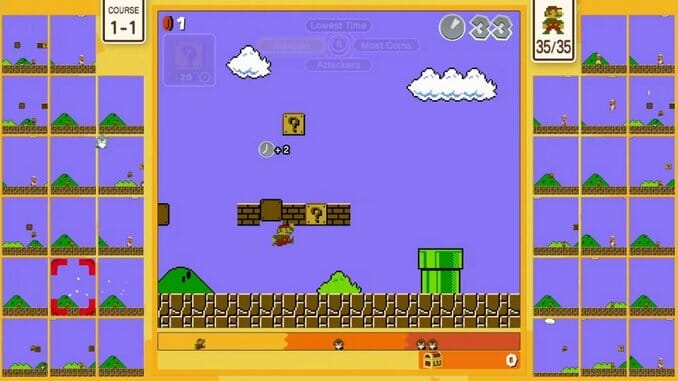How do you turn a single-player side-scroller from 1985 into a battle royale game? 35 players start on World 1-1 with a single life, and then try to be the last one alive. You’re not playing directly against each other—you won’t see other Marios running by you on your screen—but your actions will impact your rivals, dropping all kinds of extra enemies onto those familiar levels. You might even wind up facing down Bowser in the middle of World 1-2. You can actually select which other player you’d like to target, with 34 other small screens flanking the one where your game is happening; highlight the player you want to mess with, and you’ll be dumping extra Goombas and Koopas in front of them in no time. There’s also a very short time limit that kills you when it expires, and that can be increased by killing enemies or grabbing coins or power-ups. That forces you to actually engage with the levels beyond simply speeding through them as quickly as possible. Eventually every competitor will fall, and one winner will emerge.
This isn’t the first time Nintendo has turned an NES classic into a battle royale. Tetris 99 has the same basic concept, and it was one of our favorite games last year. The difference isn’t just in execution, but comes down to the inherent nature of the original games.
Tetris 99 works because it doesn’t change anything about the game’s fundamentals. Tetris has had a head-to-head mode as far back as the ‘80s, and all Tetris 99 does is take that mode and spread it out across a pool of 99 players. The garbage blocks that you dump on an opponent when you have a good clear? That’s always been a part of head-to-head Tetris. Tetris 99 also hinges on the streamlined elegance that has always made Tetris such a perfect game; instead of the wide-ranging series of obstacles and challenges you’ll encounter in Super Mario Bros., the only thing that changes about Tetris is the speed of the blocks. That mechanical simplicity makes it far easier to turn into a battle royale game.
Super Mario Bros. 35 is trying to shoehorn a game into a format that simply doesn’t work for it. It’s not that side-scrolling platformers are inherently opposed to the one-against-all nature of a battle royale—if you design a Super Mario-style game from the ground up with that purpose in mind, there’s no reason you couldn’t make a good, fun game. Super Mario Bros., though, doesn’t work in that context. Even with the need to earn extra time by grabbing items, this game still prioritizes speed over all else. And although Super Mario speed-runs are popular, and can be fun to watch and try out on your own, the game itself wasn’t really designed for them. Some levels are, sure, but overall the level architecture, the enemy placement, and the copious mysteries, from underground coin rooms to the beanstalks, actively work against running through a level as quickly as possible. Super Mario Bros. 35 is a bit like trying to turn San Francisco’s Lombard Street into a dragstrip.
It doesn’t help that the head-to-head aspect of the game is poorly explained. After several runs it still wasn’t clear to me how my actions impacted other players. There did seem to be a correlation between how quickly I ran through a level and the amount of extra enemies on screen—during one run I was near the front of the pack when I hit 1-2, and there were no extra enemies at all. There are other confusing moments throughout, too, like why the game cycles from 1-2 back to 1-1 before taking you to 1-3, or why, when you choose to start on 1-2 or 1-3 from the main menu screen, it still always starts you on 1-1.
All together, these weird issues make Super Mario Bros. 35 feel like a hastily assembled, poorly planned out gimmick of a game. It doesn’t work on either the terms of Super Mario Bros. or the new genre that it awkwardly tries to emulate, and doesn’t even adequately explain how it works to the player. As interesting a logline as “Super Mario Bros. as a battle royale” sounds, it’s an idea that never should’ve made it off whatever napkin it was scrawled onto.
Senior editor Garrett Martin writes about videogames, comedy, music, travel, theme parks, wrestling, and anything else that gets in his way. He’s on Twitter @grmartin.
